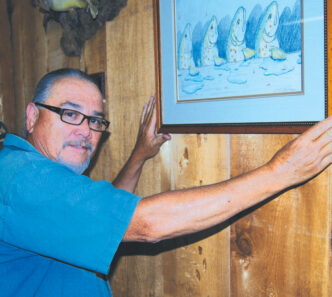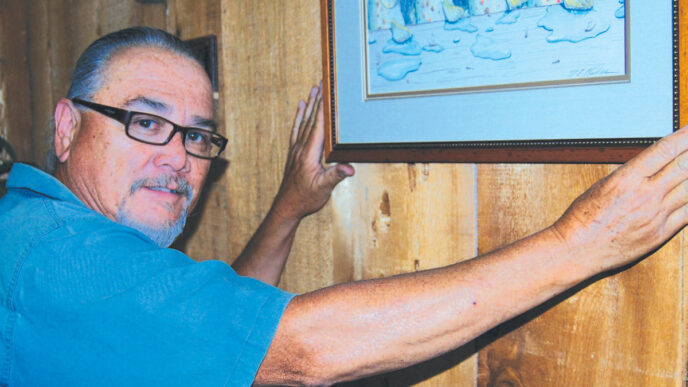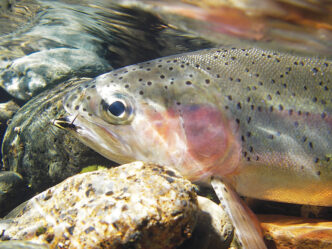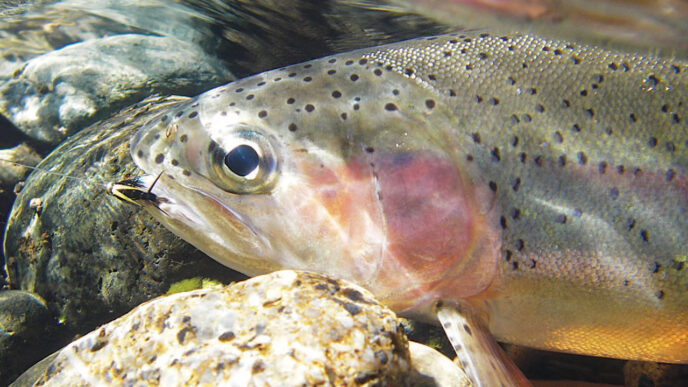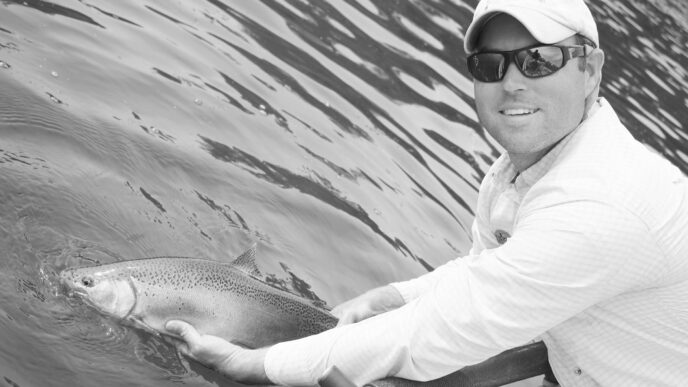Author’s note: what began as a melancholy Meander became something else in the writing: more important, urgent, and consuming. Also, complex — an article dependent on 24 sources published over a 15-year period. A few of these, issued in panic, or observed from different perspectives, or distorted for political advantage, contained what I found to be factual errors or conflicting accounts of events. I have done my best extract what appears to be true from the most reliable information, and when possible, to distill a larger truth from the whole. I apologize in advance for any inaccurate information, also for events and people left out of this narrative.
We cannot choose what haunts us. I can’t, anyway, and so it happens that today, I write about a young man named Liam Wood, a story I began a long time ago.
We never met. We did come close, on June 10, 1999. Liam was then 18 years old and had just graduated from high school. By then, he’d been passionate about fly fishing for half his life, beginning even before his mother took him to a outfitter in Oregon on his ninth birthday to get equipped and take a casting lesson. Now Liam was skilled at reading water, tied his own flies, and was a dedicated conservationist, also an aspiring fly-fishing writer whose favorite book was The River Why, by David James Duncan. Liam had a job in a fly shop, but they hadn’t needed him that afternoon, so he was fishing a small stream running through Bellingham, Washington.
Whatcom Creek was a pretty place to be at that moment. In several spots, it came close to the road I was traveling for the first time, though I had not seen it yet and was distracted anyway — a 48-year-old fly-fishing writer and writing teacher, driving a rented van with two tired children strapped into car seats in back and a wife riding shotgun. Lisa held a map on her lap and was puzzling out directions to an old housing development eight miles out of town, where we were scheduled to meet a real estate agent.
It was 5:00 P.M., give or take a few minutes. She looked up to check landmarks, then suddenly leaned across me cried, “My God, what is that?”
I followed her stare due north. In the middle distance, I thought I glimpsed flames licking the tops of tall trees, although Lisa insists she didn’t. What we both remember are clouds of coal-black smoke, churning violently and completely opaque. They had not been there 30 seconds before; in 30 more seconds, they rose hundreds of feet high.
“What is that?” Lisa said again, this time softly, from awe.
I guessed a fuel fire — from the smoke, a refinery explosion. A few moments later, I heard sirens and pulled over. By then, I knew my guess was wrong; the smoke was racing west at an astonishing speed and spread out a hundred yards along what seemed like a narrow swath. It did not stop. Not after a quarter of a mile, or a half….
I’d seen the Oakland Hills fire from on high, first from the porthole of a Southwest Airlines jet, then from my porch, not far from Park Boulevard. I’m quite sure none of that nightmare fire’s runs up dry canyons moved so quickly, nor did that fire, burning houses and land, create anything resembling the black mass now funneling skyward — an amorphous giant, some genie not yet revealed, cloaked in inky whorls that clenched into fist-shaped tornadoes like the heads of a hydra.
The smoke looked more liquid than gas. In fact, it looked alive.
Liam Wood was dead by then. The county coroner concluded he’d been overcome by fumes a few minutes before, then drowned in a river of gasoline, something like 270,000 gallons of it, spilling out of a 16-inch pipe. It poured downstream on top of the water in a 3-inch-deep tide that some witnesses described as pink, others as foamy yellow rapids.
Drowning saved Liam from another death, when two 10-year-old boys playing with a lighter on an upstream bank — or a spark from a backfire, or God knows what — ignited a 2,000-degree inferno that torched everything in and around Whatcom Creek for over 2,500 yards. The boys’ names were Wade King and Stephen Tsiorvas, friends just one day away from graduating from the fifth grade. Both were found conscious, suffering from burns over 90 percent of their bodies.
If not for their tragic error, if that’s how it happened, the gas would have exploded farther downstream, engulfed part of Interstate 5, then created conflagrations in residential neighborhoods and dense business districts all the way to Bellingham Bay. The casualties would likely have included hundreds of people, or thousands. Fifteen years later, not everyone in Bellingham knows how much gas leaked into the sewer system from the water filtration plant near the pipeline break, seeping beneath streets where several manholes erupted violently enough to leave craters.
I knew none of these details that June afternoon, parked on the side of road with a rented engine running, watching with my family as fire trucks and ambulances raced one way, police and sheriff’s department vehicles the other. A lit-up cop cruiser parked just across from us. As an officer tossed out traffic cones, his partner shouted commands and wildly waved us forward. “Keep driving! Keep driving! Do not stop!” An evacuation. I followed his instructions and still remember how strange it felt, and how wrong, to drive away from a disaster. But our flight turned surreal when we reached the shore of a long, lovely blue lake that stretched out before us. Ahead lay forested slopes climbing a small mountain, but it was a quiet expanse of water that framed a mushrooming cloud in my side-view mirror.
A mile on, we veered away into heavy woods of spruce, fir, and maple. The road rose and fell, curved back and forth, returned to the lake, and then left it again. I lost count of the emergency vehicles roaring past us, shrieking or yowping, lights flashing into the trees.
Twenty minutes later, we met the real estate agent in front of her office beside another lake, a tiny lake where trout were rising to an excellent mayfly hatch. The agent knew nothing about the fire — hadn’t noticed the smoke from her office window, couldn’t imagine what might be going on — and was eager to show us houses.
The first had no view to the west, where the fire was. Driving to the second, I spotted a large porcupine crossing a street and pointed this out to the kids. From the deck of the third house, I stared again at the black cloud, which now soared six miles into the sky.
The whole tour took about two hours. Driving out, I stopped the van again beside the little lake. Mayflies were still hatching, and trout were still rising, now amid a fall of while ash settling gently as snow.
We crossed Whatcom Creek that evening, on a bridge upstream from the fire. It looked to be a dozen feet wide. I saw a riffle on one side, which on the near bank had room for a back cast. Over the opposite side railing, I spotted a deep run half-hidden by alders and shadows. Downstream, the stream continued to smoke.
I gleaned information about the fire that evening at the motel, from a local television news station. Most of the eyewitness reports came from grimy firefighters, stunned men with eyes ringed by soot. The Olympic Pipe Line Company owned the line that had burst, along with Equilon, a joint venture between Shell and Texaco. Olympic would not speculate on the cause of the spill or break, but I heard an estimate of 80,000 gallons were released. The next morning, I learned more from a Bellingham Herald newspaper article I found in the lobby. One story ran under a headline quoting a first responder describing the three-mile stretch of stream where surveyors would eventually count 100,000 carcasses of salmon, sea-run cutthroat trout, steelhead, sculpins, and lampreys: “Everything Is Dead,” it read.
Not quite. Liam’s body had been found, but Wade King and Stephen Tsiorvas still held tight to their lives at press time. They died a few hours later. A Seattle Times article by Kim Barker offered details that were either sensational or necessary to bring the tragedy to life — or both — describing the efforts of two 16-year-olds who tried to help the burning boys: Tyrone Francisco, and Andrew Tsiorvas, Stephen’s older brother:
Wade and Stephen jumped in the water, apparently to stop the burning.
Tyrone found Wade first, and carried him back to the house. Then Tyrone heard Stephen screaming for help.
At first the boy was too hot to touch. Then Tyrone carried him back to the house as well. The older boys didn’t want to let the younger ones see each other.
“Wade didn’t want his mother to know,” Andrew Tsiorvas told The Bellingham Herald. “He said she’d be too sad and mad at him.”
Like many people who’ve seen or experienced what heat does to the human body — like any parent who fears for his or her children — I found it difficult to think about what happened to Wade King and Stephen Tsiorvas and how this was affecting their families. My mind flinches, as if burned by thought.
That is still true today.
As to Liam . . .
I’d met him now, abstractly, in stories. And while it could not have formed in an instant, that is how I remember a response in which I felt consumed by two images.
The first was pure projection. I saw a run as Liam might have seen it, standing thigh deep and bent forward, line aloft as he-as-me decides where to land his fly. Even today, I can describe the details I imagined — an alder branch above me on the left, a likely looking current seam upstream to the right. There is no fear in this conceit — no smell of gasoline or sense of death, only the anticipation of a rise. And just below the surface runs a current of regret.
The second image came straight from memory: I saw again churning fists of smoke, tornado heads, the stretch of road separating a rented van from an inferno.
The tableau is frozen, but this time, my bewilderment drops into that gut-wrenching shock you might have felt when a tall ladder slips from beneath you or a truck grill fills your windshield. In this moment, my mind is not filled by the horror of what has happened, but what will.
For several days, I wondered if Liam Woods and I were only casts away from each other when he died. No. Perhaps 10 or 20, but even that is unlikely, and since his family prefers to keep the location private, I won’t ever know and don’t need to. But in the moment when these two images collided, and they have collided hundreds of time since then, I found myself repeating a line twisted from J. D. Salinger, who took it from others: “If a body catch a body, casting through a fire.”
My family and I left Bellingham a few days later, but not before crossing Whatcom Creek again, this time over the burn. In the words of Kim Barker:
the scorched river still looked like ground zero. It looked like the sky rained napalm. It looked like Mount St. Helens. Everyone had a cliché, but no description did justice to the washed-out eeriness.
The river corridor burned white. It’s now a winding moonscape covered in ash and cottonwood dander. The smell of gasoline was still thick enough to cause headaches.
For a year, I followed stories about the Bellingham fire from Oakland. The news had gone national and international. Articles mentioned victims in passing, or sometimes not at all, but most focused on governmental investigations and civil litigation. Olympic’s early expressions of regret quickly turned into accusations against a local construction company that it blamed for damaging the 35-year-old pipeline during excavations in 1994. Olympic insisted that it had not been notified when this happened, despite the fact that one of their inspectors had been assigned to the site, also that “anomalies” in pipeline wall thicknesses, discovered in 1996 during inspections by electronic “smart pigs” — 20 feet of pipe revealed 33 gouge marks consistent with digging damage — were “subcritical” flaws that did not justify a visual examination. Then, with a federal inquiry pending, Olympic employees took the Fifth Amendment during civil cases when denied requests for immunity from criminal prosecutions.
The cause of the fire remained unknown three months later. Even so, Olympic requested permission to reconstruct the line and to open nearby lines that it believed were unaffected. Federal regulators, under scrutiny following a July 16, 1999, “advisory bulletin” issued by the National Transportation Safety Board, insisted on hydrostatic testing first.
The pipeline failed again, this time a mile and half from the first break and directly above a middle school. The possibility of incinerating hundreds of children and their teachers may have prompted testing of all of the older pipelines around the Bellingham area, but even after discovering other issues, the agency allowed Olympic to begin pumping operations, although at only 80 percent of capacity.
Olympic was not happy. Neither were other Washington residents living near Olympic lines, so the company held public forums to answer questions. Many attendees did not find these reassuring: when U.S. Representative Jack Metcalf, from Langley, Washington, suggested that “testing along full length of the pipeline will help ease the fears of state residents, and serve as an excellent indicator of the overall safety of the pipeline,” an Olympic representative responded, “We don’t think that’s necessary,” insisting that examination by electronic “pigs” — the devices that found the Bellingham pipe damages “subcritical” — was sufficient.
Not everyone agreed. And some people expanded the scope of accusations, blaming lax oversight by the Federal Office of Pipeline Safety. State Representative Kelli Linville, of Bellingham, sponsored a bill giving Washington the responsibility for regulating intrastate pipelines, improving pipeline safety, and inspecting 2,500 miles of intrastate pipelines, and on March 28, 2000, Governor Gary Locke signed into law the Washington Pipeline Safety Act. And at a May 11, 2000, hearing before the U.S. Senate’s Committee on Commerce, Science, and Transportation, Susan Harper, executive director of the Cascade Columbia Alliance (CCA), also a member of the board of directors of the National Pipeline Reform Coalition (NPRC), testified that “we learned many disturbing facts about pipelines and the inadequacy of the Federal Office of Pipeline Safety (OPS). The most frustrating lesson we learned is that this problem had plagued communities for years, and had proper action been taken by the OPS, the Bellingham nightmare could have been prevented.”
However awful the Bellingham fire was, Oakland still had 80 murders per 1,000 people per year — a figure that was much higher in our neighborhood — so in June 2000, my family moved into the house near where we’d seen the porcupine, from which I would commute to Oakland five days a month for seven years. Mayflies were hatching on the tiny lake when we arrived, and there was fishing to be found in the larger water that had framed my mirror view of the smoke cloud.
That memory already felt like a memorial vision. I continued to visit the two images, also the burned section of Whatcom Creek, where clean-up crews and volunteers had removed 6,500 cubic yards of contaminated soil, aerobically cleaned 2,000 more, and were in the process of planting over 36,000 trees. Shoots of grass struggled up through the ash, and blackberries looked ready to seize acres of opportunity, but so many scorched trunks remained that the banks felt to me like a boneyard.
I never fished on these trips. But I did collect specimens downstream from the devastation, one day finding two rock worms, a small yellow stonefly nymph, half a dozen midge pupae, and one minute mayfly. It occurred to me that Liam Woods might have been gratified by this. . . .
And soon by other developments. In 2003, three Olympic employees plead guilty to criminal charges, such as they were, with two receiving time behind bars: one six months, one 30 days, both for felony violations of the Hazardous Liquid Pipeline Safety Act. It’s more difficult to track the fines and penalties paid by Olympic and its partner Equilon, now owned by Shell Pipeline Company, but later that year. the Department of Justice announced a settlement with the corporations, which agreed to pay $92 million to the U.S. Environmental Protection Agency. EPA Regional Administrator L. John Iani made clear that the fates of three boys influenced that agency’s efforts:
The tragic deaths of Stephen, Wade, and Liam have had a profound impact on our work on this case. Their families’ unimaginable losses have steeled us as we’ve worked to hold the companies accountable for their past failures and their environmental responsibilities. Americans and the environment will be better protected because of the significant pipeline spill prevention upgrades that the companies will conduct.
Other civil trials resulted in the payment of many more millions of dollars to fire victims and their families, some of whom helped create a grassroots organization, SAFE Bellingham, whose steering committee included Marlene Robinson, Liam’s mother, and his stepfather, Bruce Brabec. SAFE would soon propose the formation of a watchdog agency, the King, Tsiorvas, Wood Pipeline Safety Trust (PST). Over the next several years, the PST collaborated with Washington state planners to develop policies and strategies that have helped reduce the number of pipeline incidents in Washington by 30 percent.
Liam would like that. But he might have been touched by another evolution, something of a legacy.
Shortly after Liam was killed, a Western Washington University history professor mailed author David James Duncan a Bellingham Herald article about him and his love for The River Why. Duncan was moved, or perhaps stricken. “Liam’s death made me heartsick for many reasons,” Duncan recalled later. “I have twice stood in urban creeks at the moment effluent was causing their fish to turn belly up. Both times I headed upstream to try to find the source of the damage. Several of Liam’s friends believe Liam did the same and that his allegiance to the creek may have cost him his life.”
And Duncan remembered: in 2001, he came to Bellingham for a signing of My Story as Told by Water. While there, he learned as much as he could about Liam’s life and met with his parents, Marlene and Bruce. After consideration, he contacted them again with a proposal to create another kind of legacy — an idea they embraced — and he offered to support his idea with time, money, and, from what I could tell from a brief meeting including Bruce Brabec, also with profound satisfaction.
The Liam Wood Flyfishing and River Guardian School (LWFRGS) is the name Liam’s parents and others chose for the project. A cadre of volunteers sought and received donations from local businesses, foundations, and individuals, also from national tackle manufacturers such as Sage, Patagonia, and Cabela’s. Western Washington University now offers two LWFRGS summer classes, one with “the dual purpose of teaching students how to flyfish and using flyfishing as a window into the structure, function, and restoration of river ecosystems,” the other to “immerse students in a wilderness setting for one week of hands-on study of flyfishing techniques, literature, stream ecology, conservation ethics, and individual relationships with nature.” Locally, the LWFRG provides programs to secondary schools and works with the Nooksak Salmon Enhancement Association’s Swimming Upstream Program and in partnership with Fourth Corner Fly Fishers and Northwest Women Flyfishers. It also supports high school summer camps in Missoula, Montana through the Watershed Education Network.
It’s no stretch to believe Liam would have appreciated his legacy. But if he had lived and written, I suspect part of his work would have told a sad and angry tale.
Hazardous materials are pumped through half a million miles of pipelines in this country — or over a million, depending on whose data you believe or whether you count hundreds of thousands of miles of “legacy” lines long abandoned, such as the one that leaked 420,000 gallons of oil into Avila Bay, near San Luis Obispo. Many of the active conduits are aging, as well, including the PG&E natural gas line that exploded in San Bruno in 2010, which was installed in 1956. “Its rupture,” according the American Planning Association, “was attributed to substandard seam welding — something that no one knew about because of an inadequate pipeline integrity management system.”
So it goes. So it has gone, and, frankly, so it will go. A recent Associated Press article reported details of oil train shipments kept secret for years, information forced out by public-records requests filed with Washington state emergency officials: 19 trains enter Washington per week. Each pulls 90 to 120 tankers of Bakken crude — the same highly flammable oil that ignited a massive fire in Lac-Megantic, Quebec, killing 47 people in July 2014 and that exploded after derailments in Alabama and North Dakota that spilled over a million gallons — more oil than in all U.S. rail accidents from 1975 to 2012 combined. Five of those trains cross Whatcom Creek every week. According to one source, these are DOT 111 tanker cars, a type the U.S. National Transportation Safety Board has noted “have a high incidence of tank failures during accidents.” Each car carries 30,000 to 34,000 gallons. At the very least, that would be roughly 270,000 gallons per train. The nation needs fuel. What kinds, how much, and for how long are questions that will take decades to determine. Meanwhile, the pipeline industry adheres to standards resembling those of other corporations that have also burned people alive: BP in the Gulf of Mexico, Ford during the Pinto years; GM in pickup trucks and cars with faulty ignition switches that have led to head-on collisions. . . .
There’s a theme here. From Whatcom Creek to Wall Street, in oil, energy, automobiles, insurance, health care, food, and drugs — the list goes on — government agencies have too often allowed industries to write and enforce their own rules. The evidence of all but absent oversight is revealed, for example, by data from the Pipeline and Hazardous Materials Safety Administration (PHMSA), available on the Web site of biologicaldiversity.com: “Since 1986 there have been nearly 8,000 incidents (nearly 300 per year on average), resulting in more than 500 deaths, more than 2,300 injuries, and nearly $7 billion in damage,” also spillage of hazardous liquids and gases totaling 4,016,559 barrels (168,695,478 gallons).” In a June 24, 2014, interview with PST Executive Director Carl Weiner at insideclimatenews.org, he described the challenge facing pipeline safety advocates. “When the judge gave us the money in the settlement, she . . . said that helping us set up a $4 million endowment is like setting up Bambi against Godzilla. And she told them they better pay attention to us.” However, “We’re up against API [the American Petroleum Institute] and INGAA [the Interstate Natural Gas Association of America] and this massive industry. There’s now three and a half of us in the office, and we’re really the only national group that focuses on pipeline safety. So how does Bambi stay alive in that environment?”
How do they? Without money in their budget to hire engineers for the complex issues they’re facing, how can they confront an industry determined to “circle the wagons and defend each other, and often they’re defending the lowest common denominator”?
But resistance is not futile. Viewed from another angle — Weimer’s once more, with emphasis added — “At the time the Bellingham tragedy happened there was no requirement that you ever had to inspect pipelines. That changed in the 2002 Pipeline Safety Act, which to a large degree came out of the Bellingham tragedy.” Even so, PHMSA statistics reported at www.fractracker.orgs suggest limits to the effect of the Pipeline Safety Act so far, identifying “1,887 incidents in the nation’s gathering and transmission, distribution, and hazardous liquids pipelines between January 1, 2010 and March 29, 2013, or an average of 1.6 incidents per day.”
In circumstances like these, the determination and grace of Liam’s parents and the parents of Wade King and Stephen Tsiorvas, the successes of the politicians and activists such as Susan Harper and Carl Wiener facing Godzillas they know will often eat them alive, the efforts of David James Duncan and others to create a legacy Liam would have loved . . . these awe me.
But they do not fill the hollow left by two images. I am standing in Whatcom Creek as Liam was. And I am watching as Whatcom Creek becomes an inferno. I am left with a question that amends Salinger and others, a rhyme that may make only visceral sense, and maybe only to me:
If a body meet a body, on the River Why . . .
The answer to that remains a horror.






